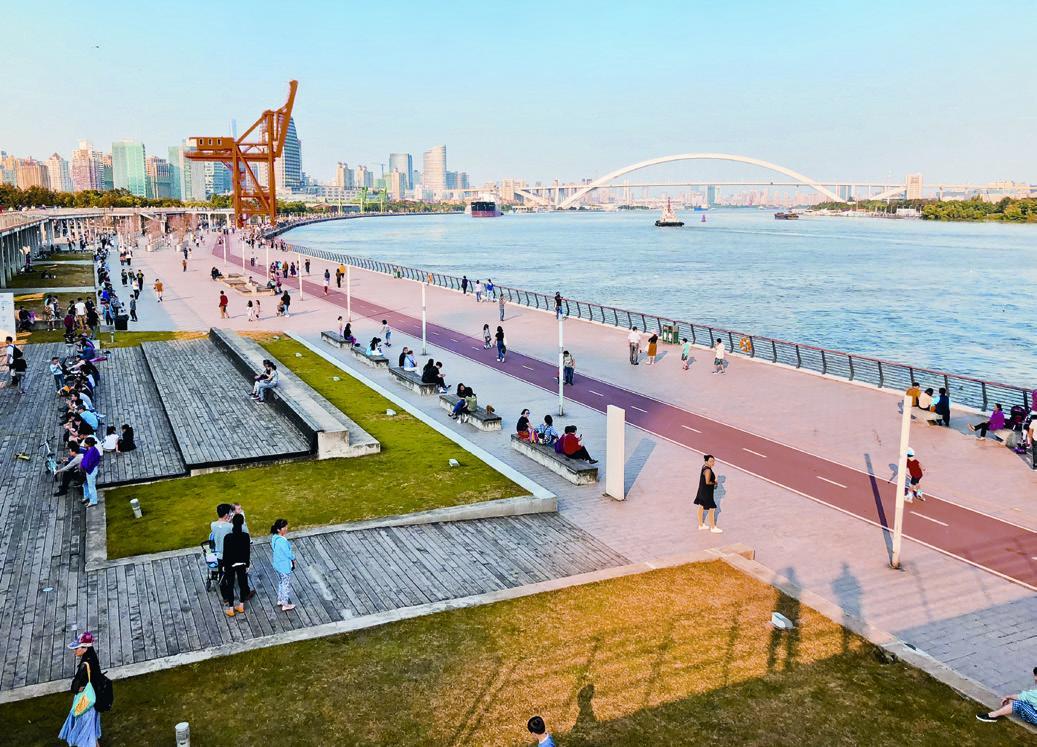Pursuing a Dream in the West Bund of Shanghai

ON the first day of the second China International Import Expo on November 5, 2019, French President Emmanuel Macron, together with Fang Shizhong, head of Xuhui District of Shanghai and chairman of the West Bund Culture and Arts Committee, jointly unveiled the five-year exhibition and cooperation project between the West Bund Art Museum and Pompidou Centre, a new cooperative initiative of top art museums in China and France.
Legend and Historical Mission of Centennial Industrial Zones
The West Bund of Shanghai is located on the bank of the Huangpu River in Xuhui District. It is 11.4 kilometers long, covering an area of 9.4 square kilometers, and includes 9.5 million square meters of total planned development area. It accomodates the core functions of a world metropolis in the overall urban planning of “Shanghai 2035.”
Ten years ago, it was still one of the most important industrial areas in Shanghai and even China.
Known as the birthplace of Chinese industry in the 20th century, it is here that Longhua Airport was located. In 1917, the airport was completed and Longhua became the birthplace of Chinas civil aviation industry. The West Bund was also where Nanpu Station of Shanghai Railway was located, established during the reign of Emperor Guangxu (1871-1908) in the Qing Dynasty. During the Battle of Shanghai against Japanese invaders, it shouldered the heavy burden of passenger and freight transport for the whole of Shanghai.
The Shanghai Cement Factory founded by Liu Hongsheng, a Chinese industrial magnate, is one of the earliest large-scale modern industrial enterprises in China. Beipiao Coal Terminal, Shanghai Synthetic Detergent Factory and Shanghai Aircraft Factory are also famous brands which once stood in the West Bund.
While Shanghai developed into a huge city with a modern service industry, and traditional industries withdrawing from the core space of Shanghai, the old industrial zones in Xuhui were faced with a new choice.
Revival Dream of Shanghais Urban Space
As early as 400 years ago, Xuhui had a brilliant cultural revival that attracted worldwide attention. Xu Guangqi (1562-1633), a famous scientist in the late Ming Dynasty (1368-1644), launched the Guangqi Plan with the goal of introducing Western learning to the East. Shanghais Xujiahui (in Xuhui District) became the first place exposed to Western culture in modern China.
The proposal of the West Bund Cultural Corridor marked another revival period for Xuhui District.
In 2008, Shanghai launched the Huangpu Riverside Comprehensive Development project. In 2010, Xuhui Riverside Open Space was completed, in conjunction with the Shanghai World Exposition. In 2011, the West Bund Cultural Corridor was established. Barely 10 years ago, the West Bund of Shanghai was a rust-belt, featuring the iron, coal, sand, and oil industries. Ten years later, a group of internationally influential art venues began to take shape in the area, including the Long Museum transformed from a coal terminal, the Yuz Museum transformed from the McDonnell-Douglas Hangar, and the West Bund Art Center transformed from the Shanghai Aircraft Manufacturing Factory.
In the past decade, the West Bund has established and successfully launched three major self-owned branded events: West Bund Music Festival, West Bund Biennale of Architecture and Contemporary Art, and the West Bund Art & Design.
In the recent past, more and more leading art events were launched in the West Bund. In October 2019, the opening ceremony of the Shanghai International Artwork Trade Center was established here. Two days later, Shanghais first international art trading month was launched, with 112 activities. Effective measures, such as a one-stop customs clearance service, the establishment of a green channel for business approval, and the strengthening of financial support, have been implemented and attracted much attention. During the international art trading month, the value of overseas artwork exhibitions, sales and auctions exceeded RMB 9.1 billion.
“Double A” Engines Driving New Development of Urban Space
As the new decade is approaching, the West Bund has launched the Double A strategy. One A represents art: the West Bund is building itself into one of the regions with the highest concentration of art facilities in the world; and the other A represents artificial intelligence, the West Bund has hosted the International summit on the development of artificial intelligence for three consecutive years to create the most dynamic environment for AI that promotes the mutual empowerment of culture, art, and artificial intelligence.
Under the guidance of the Double A strategy, the West Bund is accelerating the construction of three benchmark projects, namely, the media port, the smart valley, and the financial center, and is actively constructing a composite industrial structure in which cultural creativity, artificial intelligence, and innovative finance are mutually supportive. Gathering 20-odd cultural entities such as the Long Museum, the Yuz Museum, the West Bund Art Museum and the West Bund Theater Community, this region will become a highlight of Asian art. The West Bund in its progressive transformation will attract the most creative and promising artists of Shanghai, and realize the citys dream to become a global cultural hub.

